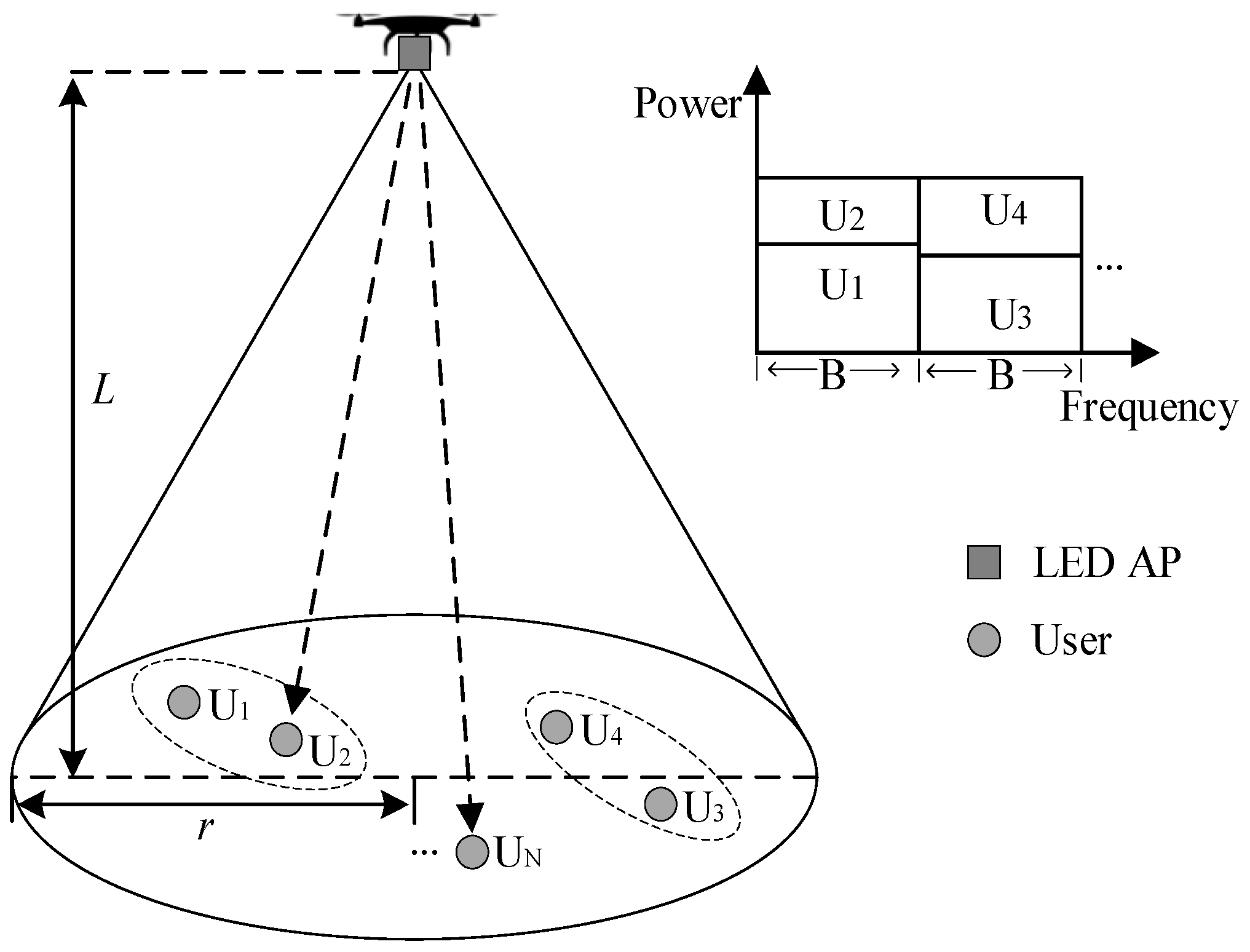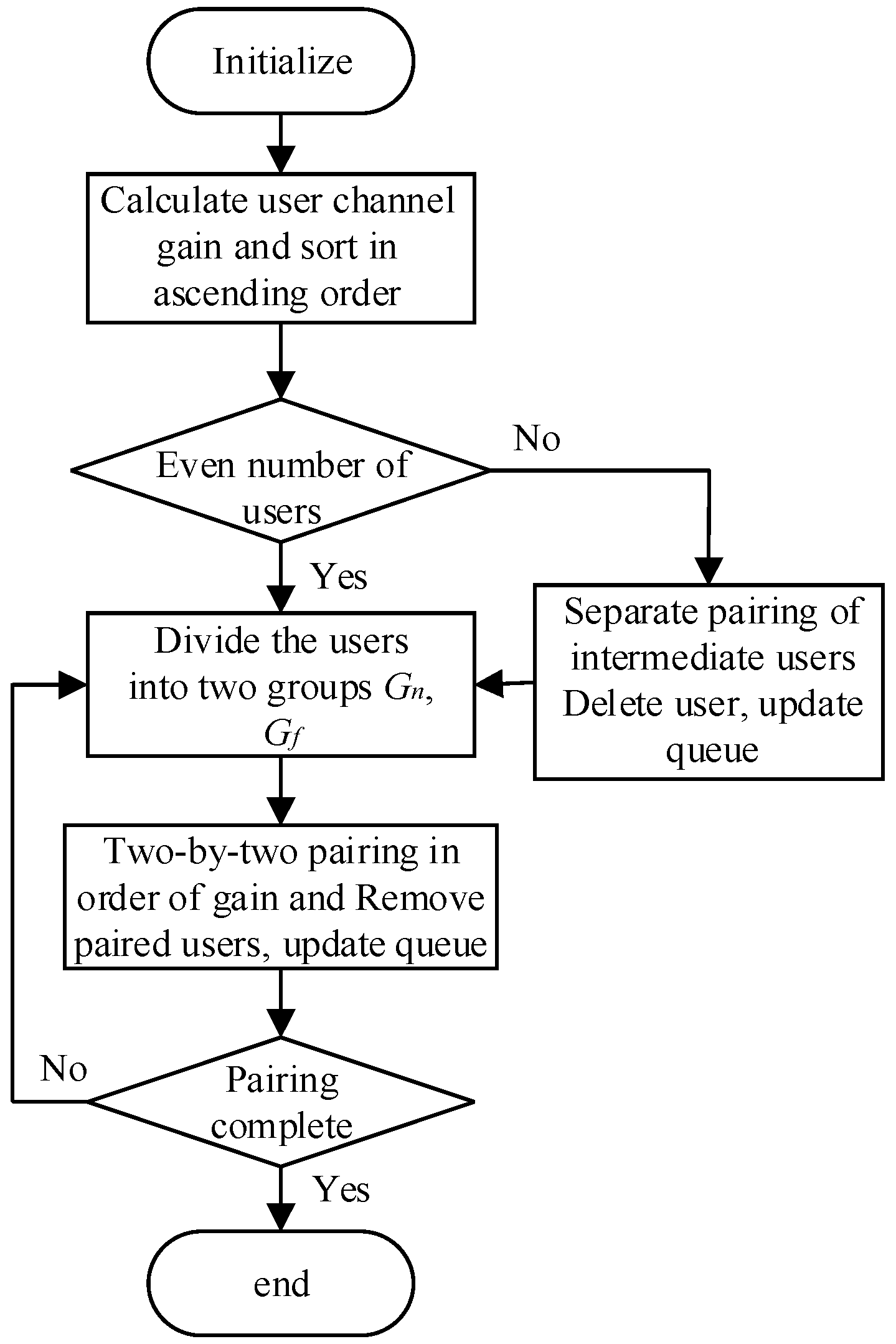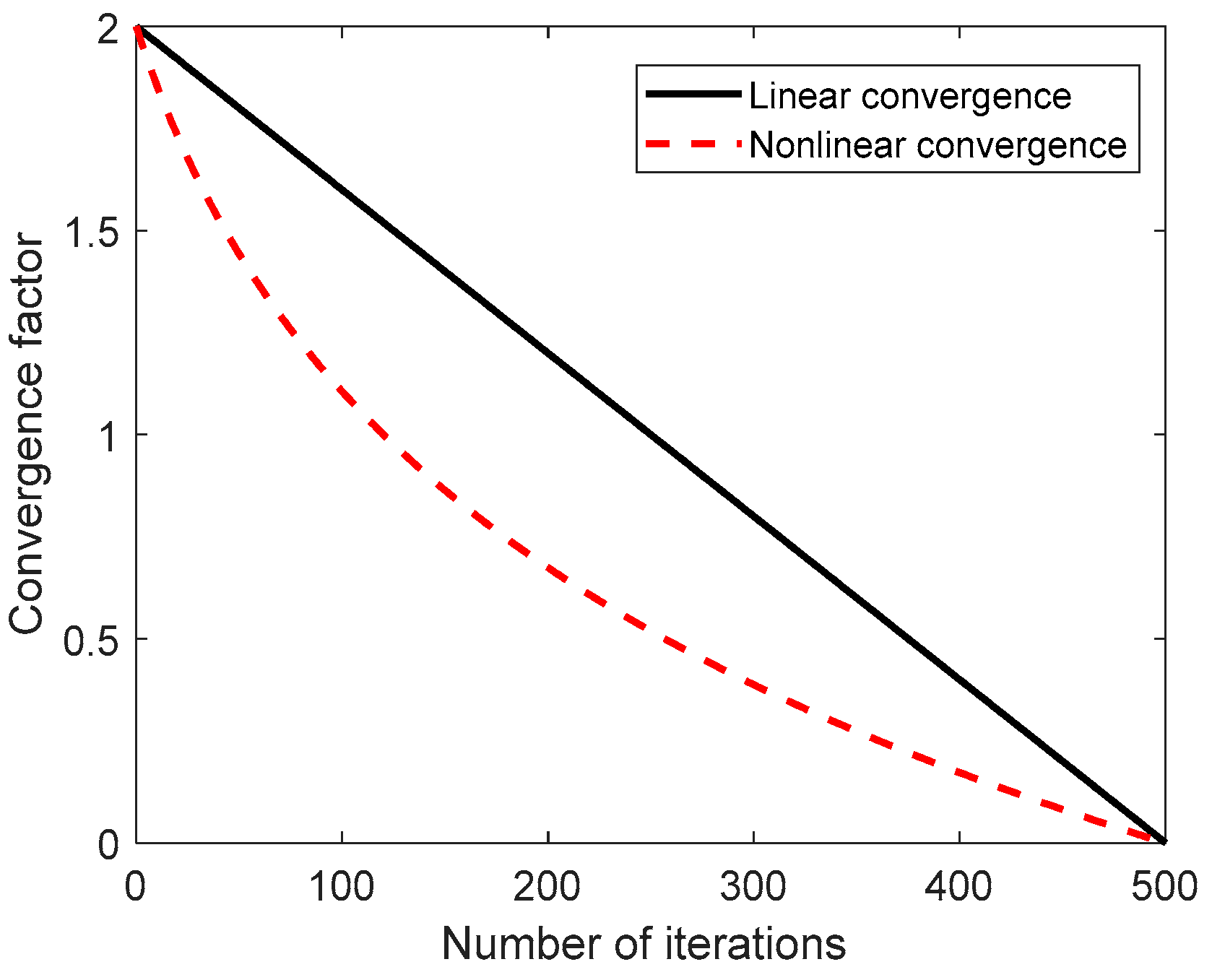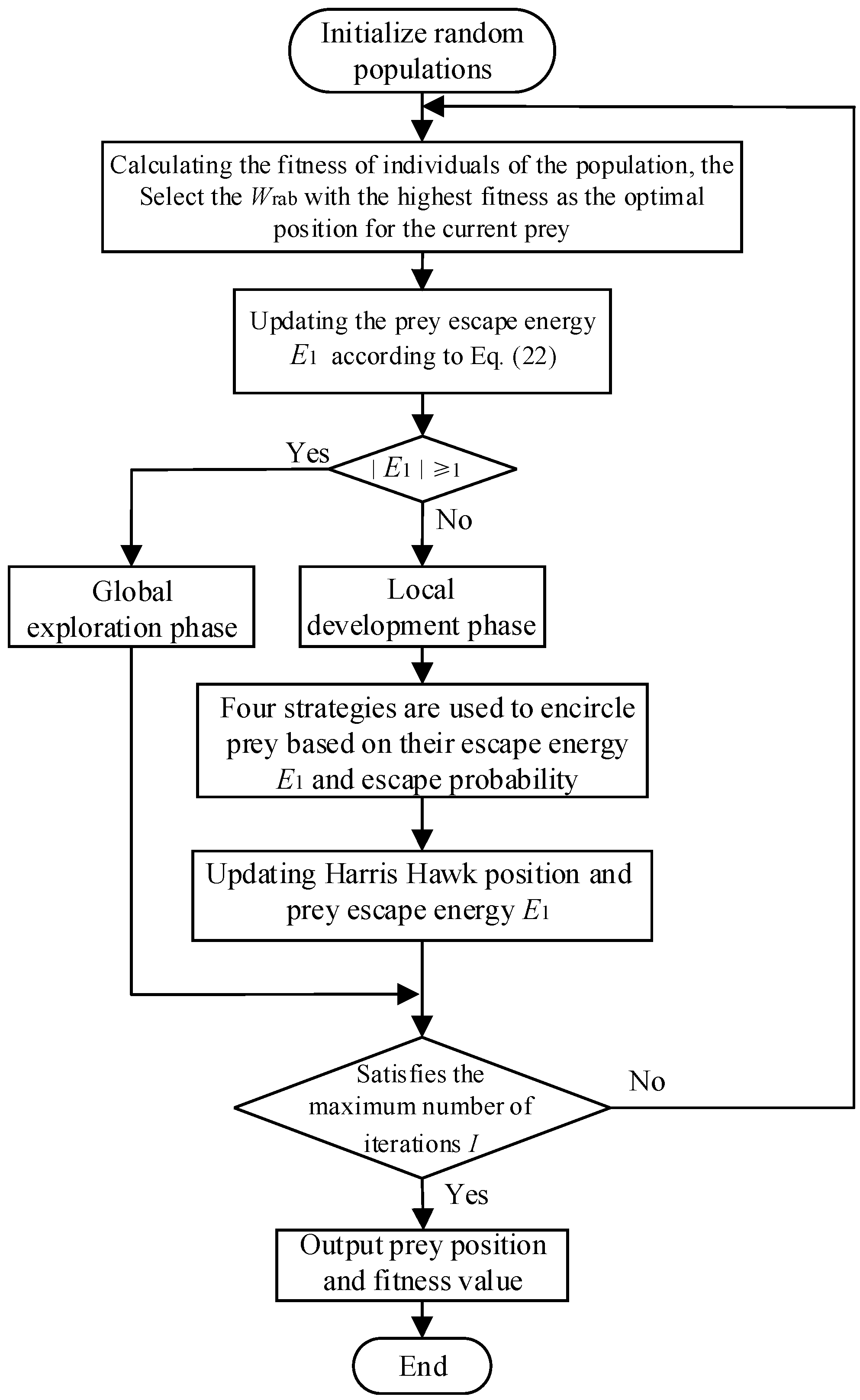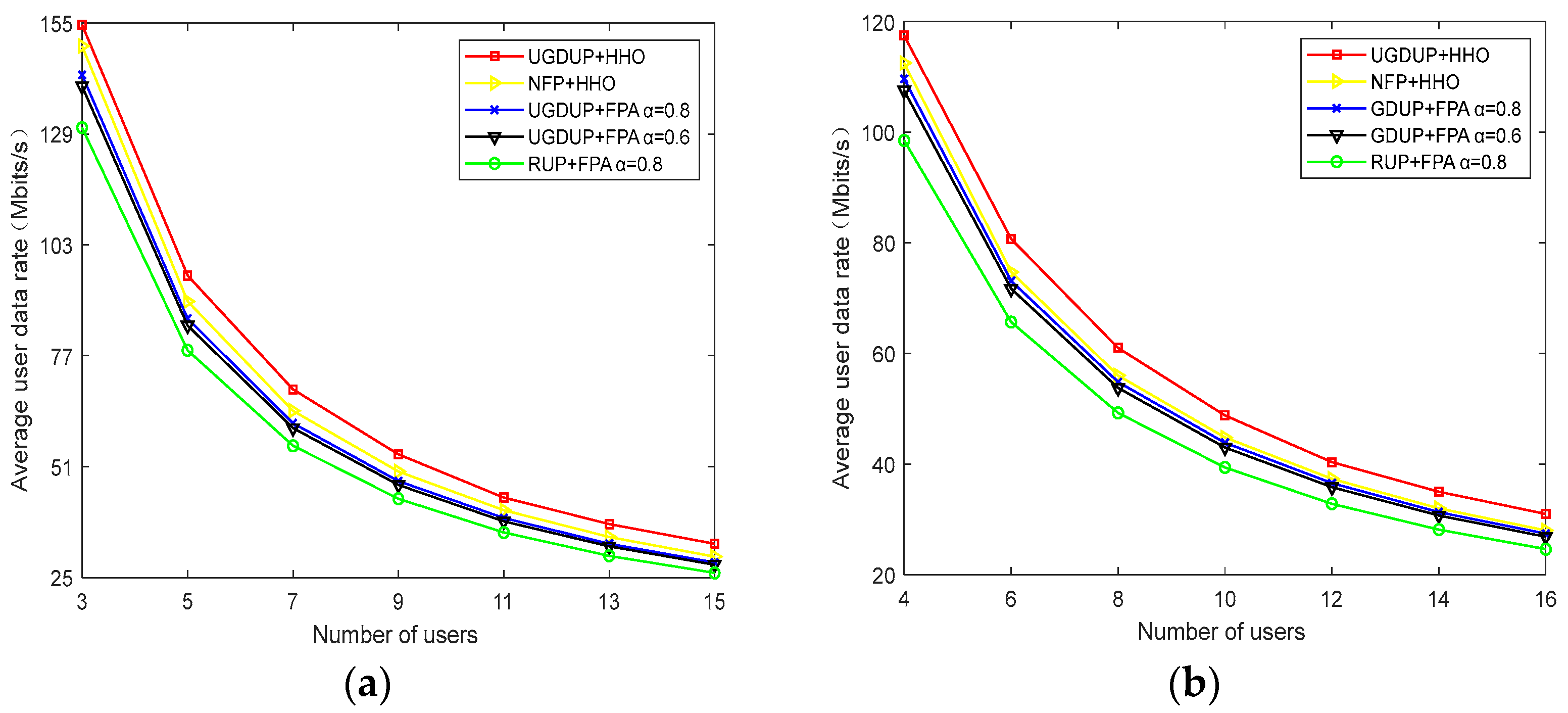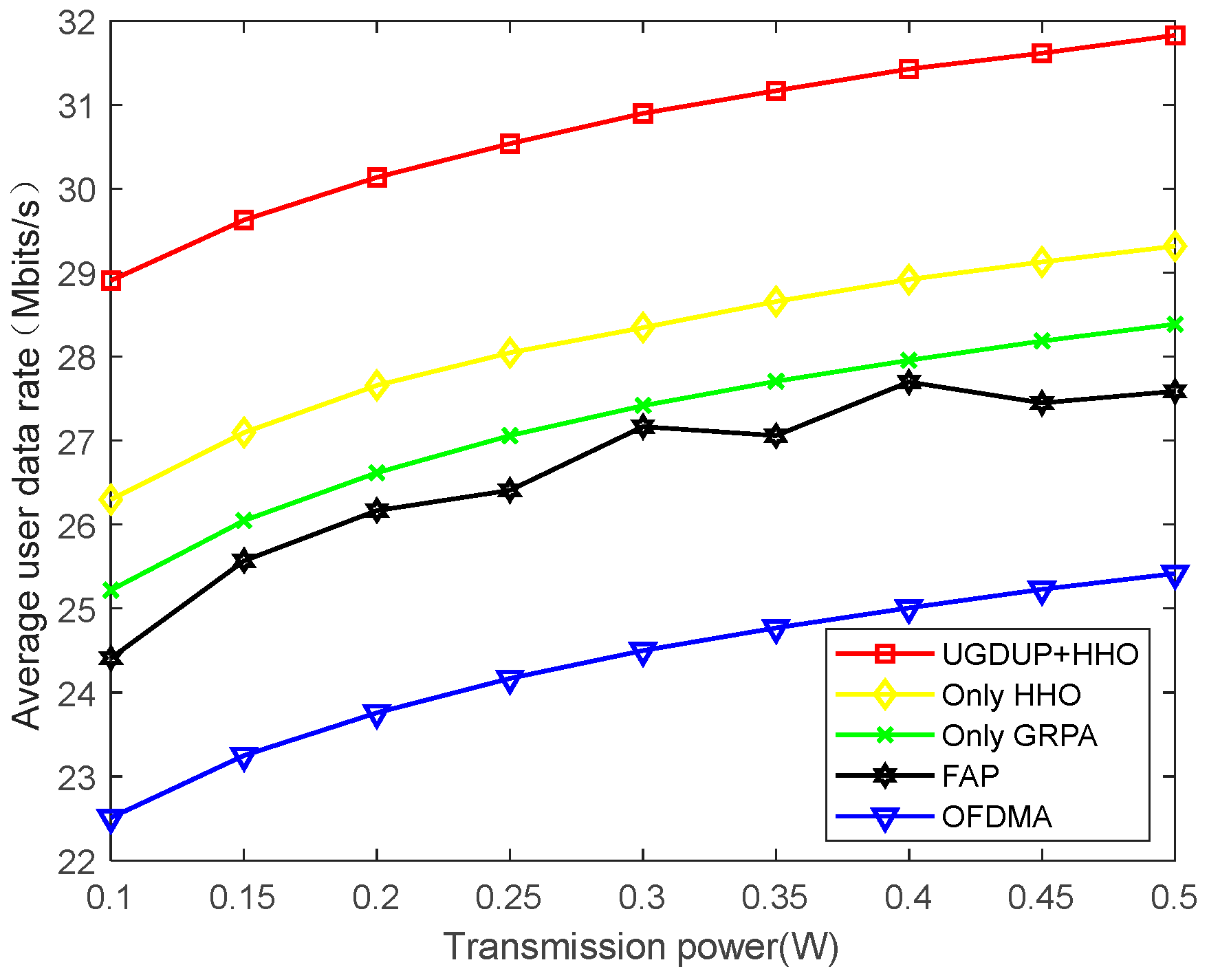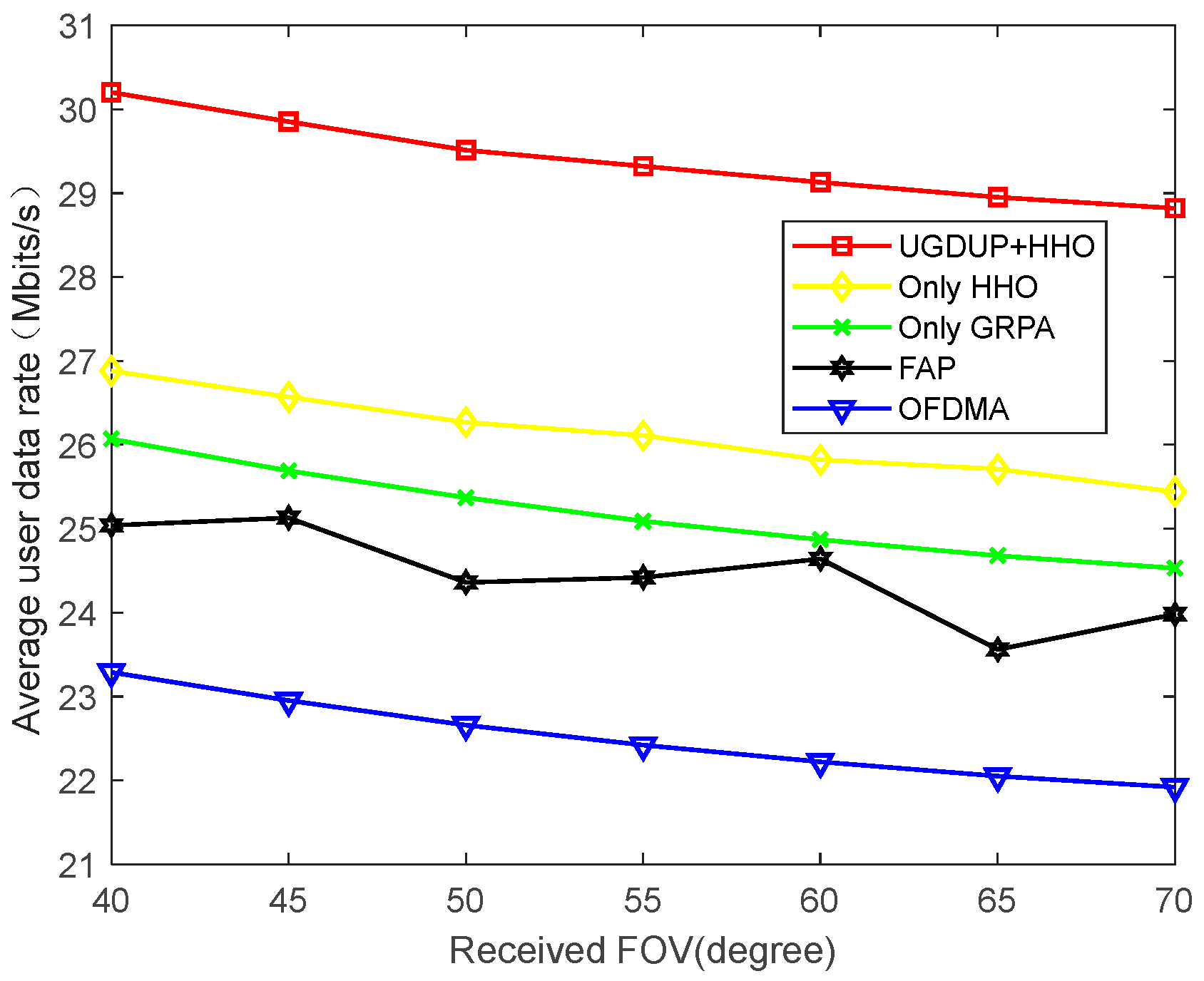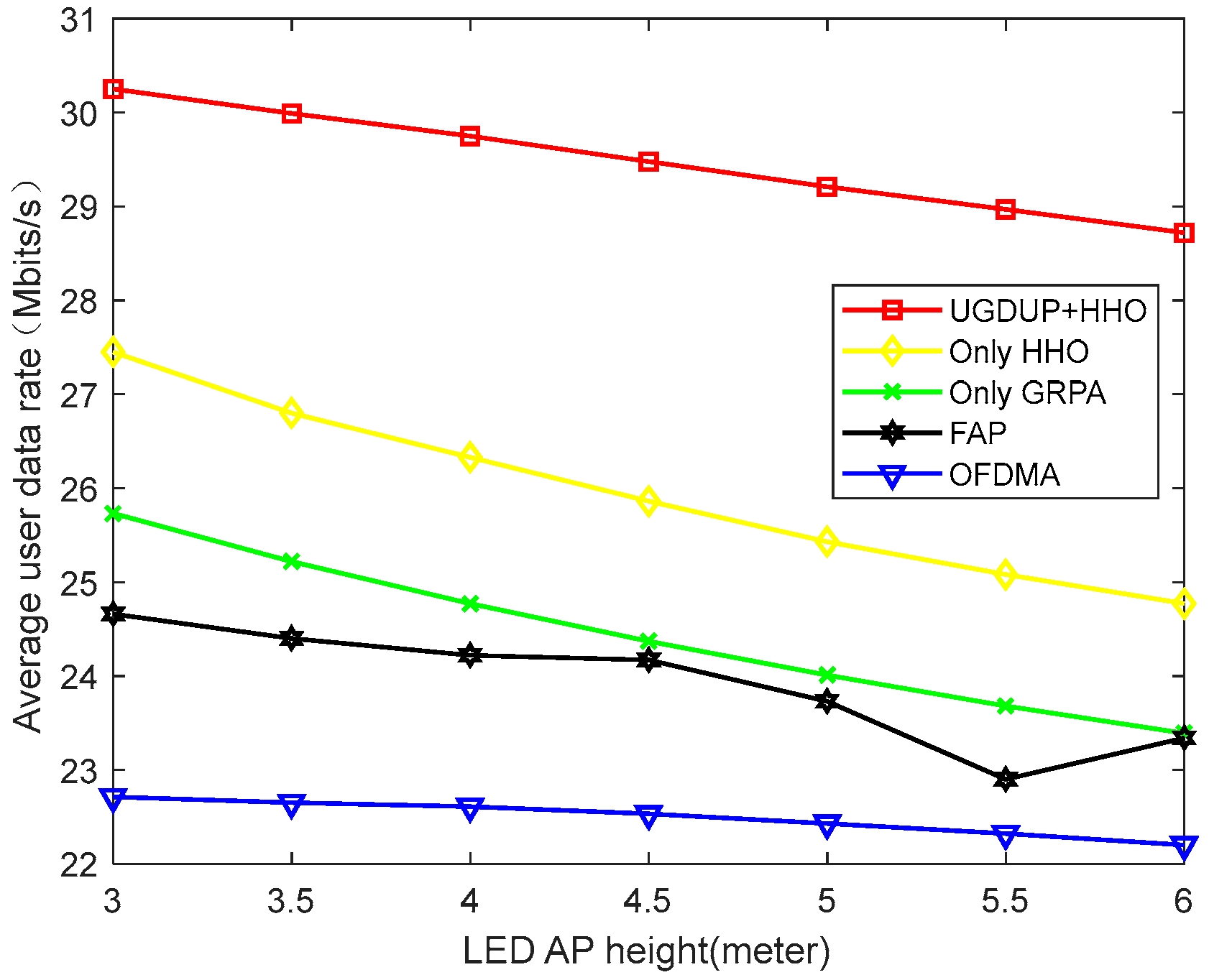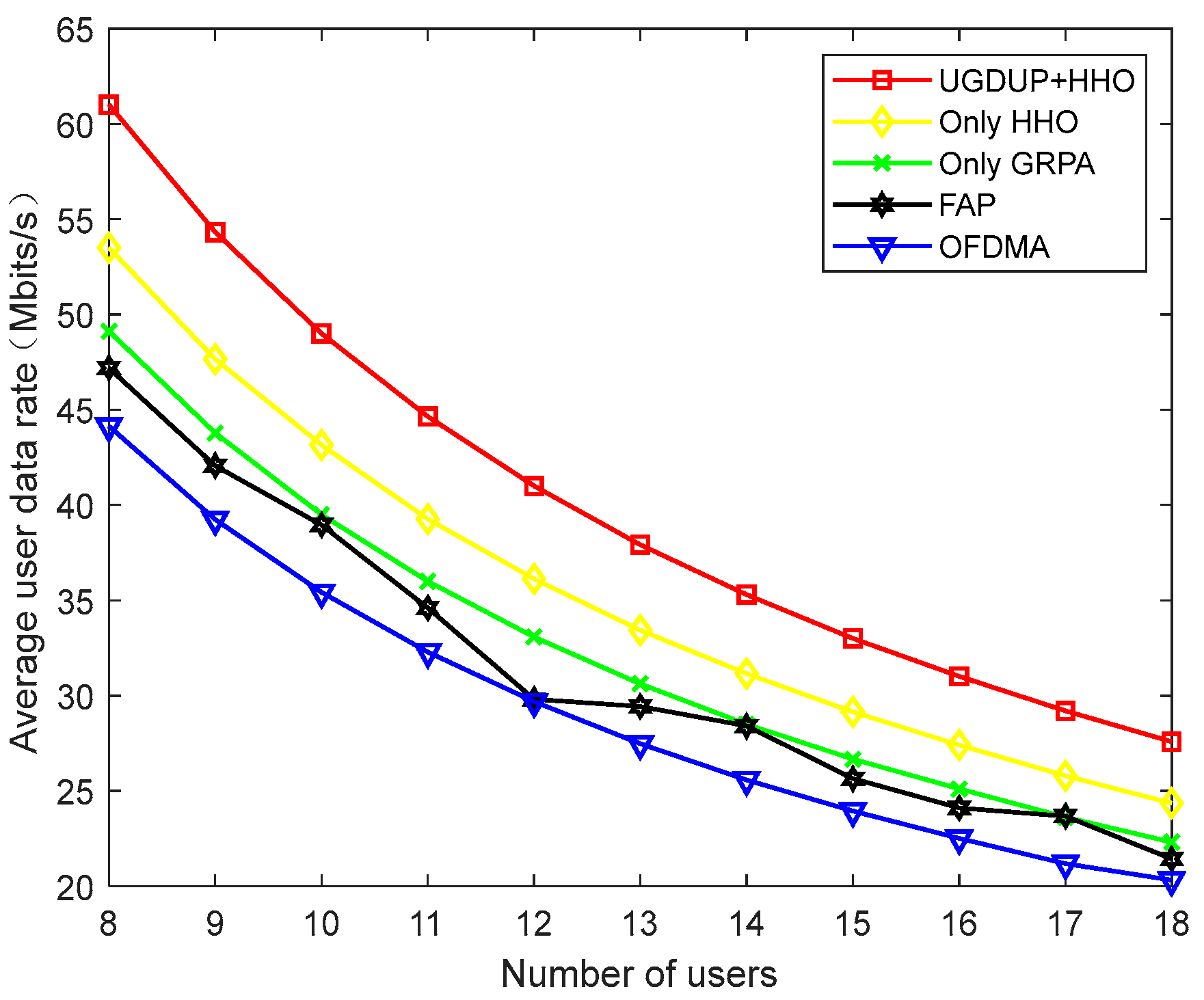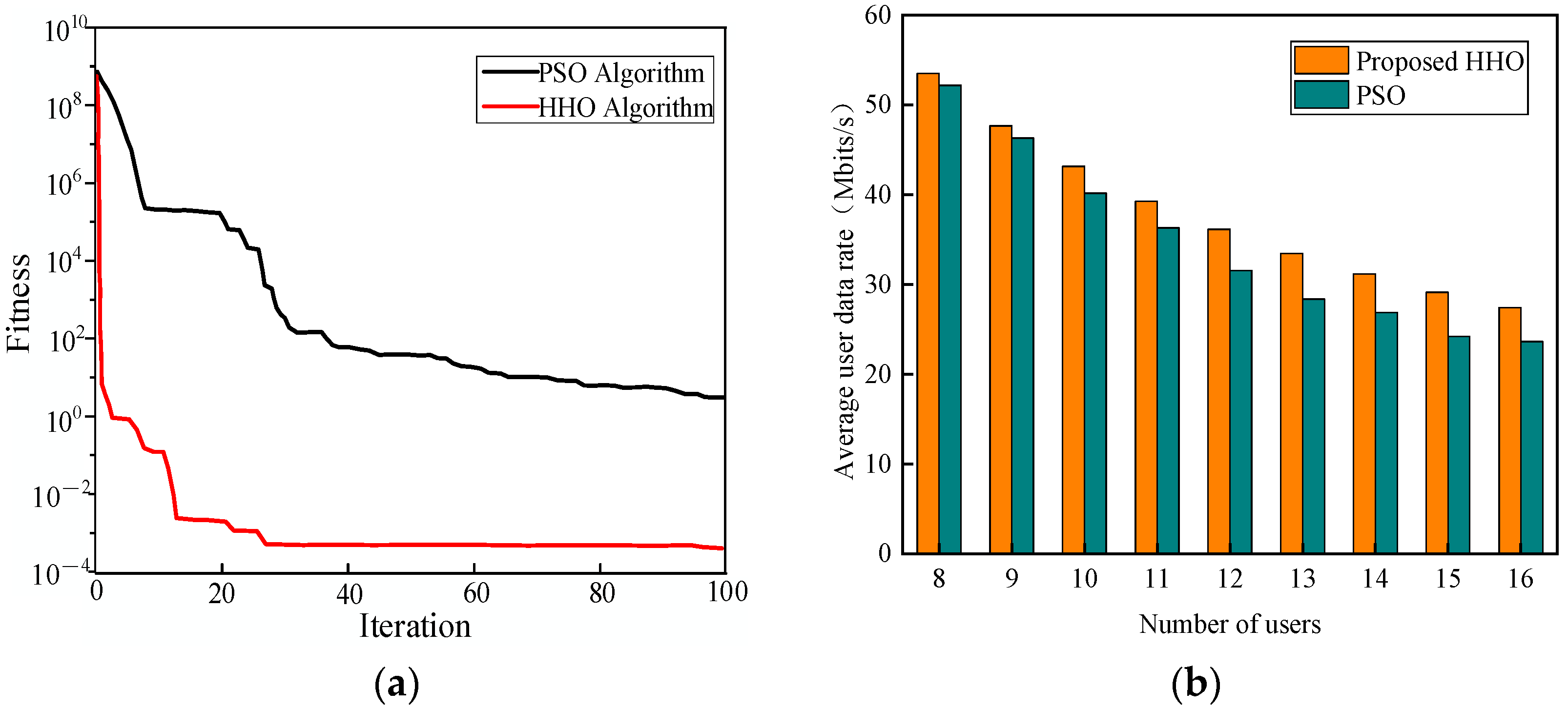1. Introduction
With the increasing scarcity of spectrum resources, radio frequency (RF) communications can no longer meet the growing bandwidth demands [
1,
2]. VLC, as a new high-speed data transmission technology that uses a low-power light-emitting diode (LED) as a light source, taking into account both illumination and communication [
3], is gradually gaining widespread attention. In addition, VLC has the advantages of high security and no RF radiation [
4], and VLC technology is expected to be an alternative to RF communication in many applications [
5]. In VLC systems, since LEDs can only support modulation bandwidths of tens of MHz, the traditional orthogonal multiple access scheme can no longer satisfy the status quo of large-scale user access and the scarcity of spectrum resources [
6]. NOMA technology allows multiple users to share the same time and frequency resources, which can provide access to large-scale users, offering greater spectral efficiency [
7]. The NOMA technique is an emerging multiple access scheme for wireless communication networks, which can be combined with drone-assisted communication to ensure higher spectral efficiency and lower communication delay [
8]. In addition, the NOMA technique has also been shown to be suitable for VLC systems, providing high spectral efficiency and system throughput [
9,
10].
In the NOMA-VLC system, the data of different users are superimposed by different power levels at the transmitter side and decoded at the receiver side to obtain the original user data by the successive interference cancellation (SIC) technique [
10]. Power allocation and user grouping are two important issues that affect the transmission of user data. Reference [
10] proposed a gain ratio power allocation (GRPA) strategy that takes into account the user channel conditions to ensure efficient and fair power allocation, and this method improves the throughput of the system. Reference [
11] investigated the sum log user rate maximization problem for the NOMA-VLC downlink and proposed a low complexity optimal power allocation algorithm, which compared to the traditional orthogonal frequency division multiplexing access (OFDMA) scheme, the proposed scheme has a higher system and rate. Reference [
12] used a meta-heuristic optimization algorithm to compute the power allocation coefficients of the users in a NOMA-VLC-based system, which provided a significant improvement in the summation rate under fairness and light intensity constraints. References [
10,
11,
12] adopted different power allocation methods to obtain good system performance gains, but these studies did not take into account the problem of NOMA user grouping. Grouping NOMA users can improve the SIC decoding performance of the receiver and further improve the system performance. Therefore, Reference [
13] studied the user grouping and power allocation problems in 3D NOMA-VLC systems, considering the problem of different heights of user locations, and the proposed scheme resulted in an effective improvement of the average user data rate performance of the system. Reference [
14] proposed a joint user grouping and power allocation scheme, designed a low-complexity dynamic user grouping algorithm, and derived a closed-form optimal power allocation expression for maximizing energy efficiency using Dinkelbach’s method and Lagrange’s pairwise decomposition method, and the proposed method can effectively improve the energy efficiency of the NOMA-VLC system.
In most existing studies, LED AP is fixed to the ceiling, without considering the quality of service for users at the edge of the communication cell. The study of LED AP position optimization is the key to further improve the performance of the NOMA-VLC system. In recent years, drones have been widely used in communication, monitoring, military, and other fields due to their advantages of lightness, flexibility, strong mobility, and wide coverage [
15]. Drone-assisted VLC is gradually emerging, and drones can carry LEDs for flexible communication and dual functions of lighting [
16]. At present, studies on drone-assisted VLC mainly focus on the analysis and improvement of the communication network performance [
17].
In this paper, the performance of the drone-assisted NOMA-VLC system is investigated. While taking into account the problems of user pairing, power allocation, and AP location, a user pairing strategy with uniform channel gain difference for any number of users is designed, and based on the user pairing, an effective scheme for the joint optimization of the power allocation and the LED AP location based on the NOMA technique is proposed. This scheme constructs a target function with constraints to maximize the average user data rate, introduces the idea of penalty functions, and transforms the optimization problem with constraints into an optimization problem without constraints. Then, the HHO algorithm based on the nonlinear energy convergence factor is used to solve the problem, and the optimal user power allocation factor and the location of the AP are finally obtained. The simulation results show that the proposed NOMA-based VLC resource allocation scheme can better improve the average user data rate performance, as well as satisfy the user’s quality of service, compared to other classical schemes. It is verified that the HHO algorithm based on the nonlinear energy convergence factor has faster convergence speed.
4. Results and Analysis
In this paper, the Monte Carlo method is used to perform extensive simulations of the proposed optimization problem to demonstrate the effectiveness of the proposed algorithm, and the system model is shown in
Figure 1. In the system, a drone carries a LED as an AP for communication, and the users are randomly distributed in a small area with radius
r. The drone can be moved to ensure the quality of service for each VLC communication user. The other system simulation parameters are shown in
Table 1.
In order to demonstrate the performance of the user pairing (UGDUP) and HHO algorithms proposed in this paper, different pairing algorithms and power allocation algorithms are used as comparative algorithms, such as the Random Users Pairing (RUP) algorithm [
1] and the Near-Far Pairing (NFP) algorithm [
1], as well as the classical NOMA-based Fixed Power Allocation (FPA) algorithm [
23] and GRPA algorithm [
10]. Additionally, this paper also includes a comparison of the HHO scheme that does not consider user pairing and a NOMA scheme with a Fixed Access Point (FAP) that allocates power solely through the HHO algorithm, using them as contrasting algorithms. The OFDMA scheme used in the literature [
24] is also compared to show the performance advantages of the NOMA scheme.
Figure 7 shows the relationship between the average user data rate and the number of users for different user pairing algorithms and power allocation algorithms. It can be found that the average user data rate decreases with the increase in the number of users, no matter whether it is the number of odd or even users. This is due to the fact that, in the case of a small number of users, each user occupies more band resources and allocated power, so there is a better data transmission rate. When the number of users is small, the difference between the user data transmission rates under different algorithms is large, and as the number of number of users becomes more, the performance difference between different algorithms becomes less. Among them, the performance obtained by the UGDUP and HHO algorithms proposed in this paper is better, and the performance obtained by the RUP algorithm and FPA algorithm is the worst. With the same user pairing algorithm, the performance obtained with HHO algorithm is better than the performance obtained with FPA algorithm with power allocation factors
and
. This is due to the fact that the power allocation to users using the HHO algorithm makes the power allocation factor inconsistent between different user pairs, maximizing the user data rate within each user pair as much as possible based on the user’s request rate. This power allocation method is more flexible. By dynamically adjusting the power allocation factor to find the optimal solution of the problem, i.e., it ensures the fairness of the power allocation and improves the performance gain of the system. When both HHO algorithms are used, the UGDUP algorithm outperforms the performance obtained by the NFP algorithm, due to the fact that the use of the NFP algorithm makes the channel gain difference between different user pairs non-uniform, resulting in a lesser rate gain being obtained by the user pairs with a relatively small channel gain difference. Under the FPA algorithm, both with an power allocation factor
of 0.8, the UGDUP algorithm outperforms the RUP algorithm. This is due to the fact that the RUP algorithm has a random nature of user pairing that does not take into account the channel conditions of the users, which makes the fairness of the power allocation decrease and fails to satisfy the quality of service of the individual users, which leads to a reduction in the data transmission rate obtained by the users.
Figure 8 shows the relationship between the average user data rate and transmission power for different user pairing algorithms and power allocation algorithms. It can be seen that, as the transmission power increases, the average user data rate also increases, and the increase gradually becomes slower. This is because the increase in transmission power allows the users to allocate more power to gain a better transmission rate. Among them, the UGDUP and HHO algorithms proposed in this paper have the best performance. When the UGDUP and FPA algorithms are used, the performance obtained when the power allocation factor
is 0.8 is better than that obtained when the power allocation factor
is 0.6. The RUP algorithm and FPA algorithm have the worst performance. It can also be observed from the graph that, under the same algorithm, the performance achieved with 15 users is overall better than that with 16 users. This is because, in the case of an odd number of users, the middle user occupies the same frequency band resources separately from the users in other groups, which allows for a better transmission rate and thus enhances the overall system performance.
In order to verify the importance of user grouping and the performance of the algorithm proposed in this paper,
Figure 9,
Figure 10,
Figure 11 and
Figure 12 show the relationship between different parameters and the average user data rate of the system.
Figure 9 shows the relationship between the average user data rate and the transmission power under different algorithms, from which it can be seen that the average user data rate shows an increasing trend as the transmission power increases, and the performance obtained by the four NOMA schemes in the figure is better than that obtained by the OFDMA scheme. It shows that NOMA technology enables multiple users to share spectrum resources and has higher spectrum efficiency compared to the OFDMA scheme, while NOMA users can occupy more spectrum resources than OFDMA users for a certain system bandwidth and number of users, thus obtaining a higher transmission rate. Among the four NOMA schemes, the best performance is obtained using the UGDUP and HHO algorithms of this paper, the second best performance is obtained by the Only HHO algorithm, followed by the Only GRPA algorithm, and the worst performance is obtained by the FAP algorithm. This is due to the fact that all users share the same spectrum resources without considering user grouping, and under the guarantee of SIC decoding performance, according to Equation (9), it can be seen that the weak users are subjected to a greater amount of co-channel interference, which leads to a decrease in the user’s SINR and makes the user’s transmission rate lower. Therefore, in NOMA systems with a large number of users, the scheme proposed in this paper simultaneously considers the issues of user pairing, power allocation, and AP location, resulting in an effective improvement in the system performance. It can also be seen in
Figure 9 that the performance obtained by the Only HHO algorithm is better than the performance obtained by the FAP algorithm. This is due to the fact that the FAP algorithm only optimizes the power allocation to the users, and the position of the drone is randomly fixed in the air without taking into account the optimization of the AP position, which does not guarantee the quality of service to all the users, thus making the performance of the average user data rate decrease.
Figure 10 shows the relationship between the user’s received FOV angle and the average user data rate, and it can be seen that, as the user’s received FOV angle increases, the average user data rate exhibits a decreasing trend, which is due to the fact that the increase in the FOV angle makes it impossible for the concentrator to maintain the optimal convergence in all directions, which leads to a decrease in the efficiency of the convergence of the optical signals in some areas, which, in turn, affects the concentrator gain. Equation (2) demonstrates the relationship between the FOV angle and the concentrator gain
. The FOV angle is in the range of 0 degrees to 90 degrees, and as the FOV angle of the field of view increases, the concentrator gain decreases, causing the channel gain of the user to decrease, which, in turn, leads to a decrease in the average user data rate performance. The proposed algorithm also takes into account the user pairing situation, AP location, and power allocation factor and shows a better average user transmission rate performance than the other algorithms. Through the above analysis, increasing the user’s field of view angle will have a certain impact on the gain of the condenser, so, in practical applications, detailed system design and testing should be carried out according to the specific needs and scenarios to obtain the best communication performance and effect.
Figure 11 shows the relationship between the AP height and the average user data rate, and it can be seen that, as the AP height increases, the average user data rate shows a decreasing trend, which is due to the fact that the increase in the AP height makes the distance between the user and the AP larger, and the channel gain of the user decreases consequently, leading to a decrease in the transmission rate of the user. The algorithm in this paper takes into account the optimization of the AP location and improves the performance by about 23.17% compared to the FAP algorithm, and the system performance degradation is small as the AP height increases, indicating that user grouping can lead to a higher performance gain. The performance improvement of the Only HHO algorithm without considering the pairing is not obvious, which is because the high AP height makes the channel gain of the users smaller, and the channel gain difference between users also decreases. It is difficult to further improve the data transmission rate of users only through power allocation optimization. Therefore, this paper conducted user pairing according to the channel gain difference between users. Combined with the AP location and power allocation optimization, the data rate performance of the average user is greatly improved.
Figure 12 shows the relationship between the number of users and the average user data rate for different algorithms, and it can be seen that an increase in the number of access users leads to a decrease in the average user data rate. This is due to the fact that the spectral resources and transmit power of the system are certain, and an increase in the number of users reduces the data rate. The scheme proposed in this paper takes into account the user pairing problem and reduces the interference between users within the NOMA group, so the performance obtained by the scheme in this paper is better than that obtained by the Only HHO algorithm. The HHO scheme achieves better performance than the GRPA scheme, because the GRPA scheme only considers the fairness of power allocation without considering the overall system performance, while the HHO scheme optimizes the system performance while carrying out power allocation. The FAP algorithm does not take into account the optimization of the AP location, which may lead to obtaining a performance close to that of the OFDMA scheme, while the other three NOMA schemes obtain a performance superior to that of the OFDMA scheme.
In order to demonstrate the advantages of the HHO algorithm proposed in this paper,
Figure 13 shows a comparison between the HHO algorithm and the PSO algorithm [
17].
Figure 13a shows the curve of the number of iterations versus the value of the fitness function, which shows that the HHO algorithm has a faster convergence speed and has a stronger ability to find the optimal solution than the PSO algorithm. This is due to the fact that the HHO algorithm has the ability to search globally to a certain extent, while the PSO algorithm is prone to fall into local optimal solutions during the search process.
Figure 13b shows the change between the number of users and the average user data rate under the two intelligent optimization algorithms. It can be observed that the performance obtained by the HHO algorithm is superior to that of the PSO algorithm. When the number of users is small, the performance gap between the two algorithms is not significant. However, as the number of users increases, the HHO algorithm demonstrates better system performance. This is because the increasing number of users elevates the complexity of the optimization problem, allowing HHO to exhibit superior global search capability. Nevertheless, this also leads to a reduction in the optimization ability of the PSO algorithm. The performance gap between the HHO algorithm and the PSO algorithm obtained is the largest when the number of users is 15, and the HHO algorithm improves the performance by about 20.31% compared to the PSO algorithm.
Figure 14 shows the convergence relationship between the number of iterations and the average user data rate for different convergence factors, and it can be seen that the HHO algorithm with nonlinear convergence factor
used in this paper reaches convergence at about 50 iterations, and the HHO algorithm with linear convergence factor
reaches convergence at about 100 iterations. It shows that the nonlinear convergence factor HHO algorithm adopted in this paper has a faster convergence speed, which, in turn, proves that the parameter tuning scheme proposed in this paper effectively facilitates the smooth transition of the HHO algorithm from the pre-exploration to the post-exploitation development and maintains the equilibrium between the two, which, in turn, accelerates the convergence of the HHO algorithm and improves the solution accuracy.
